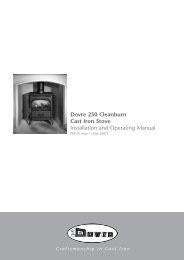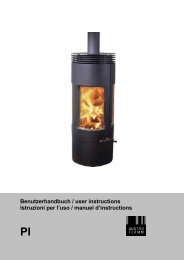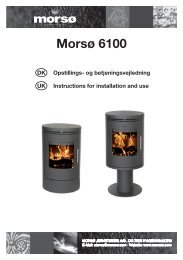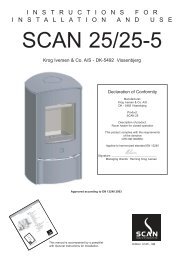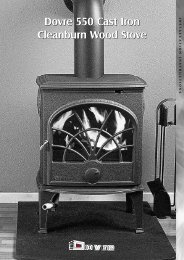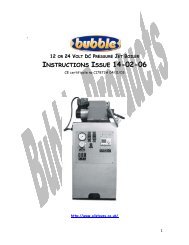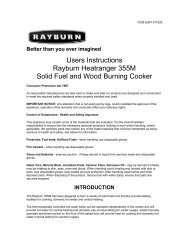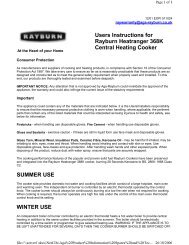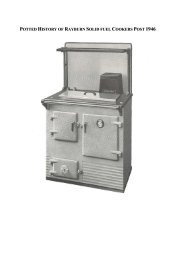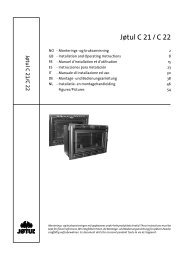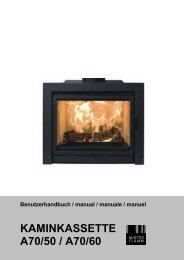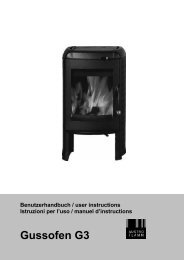Users Instructions. Rayburn Heatranger 355SFW Solid Fuel and ...
Users Instructions. Rayburn Heatranger 355SFW Solid Fuel and ...
Users Instructions. Rayburn Heatranger 355SFW Solid Fuel and ...
- No tags were found...
Create successful ePaper yourself
Turn your PDF publications into a flip-book with our unique Google optimized e-Paper software.
01/06 EOPI 514409Better than you ever imagined<strong>Users</strong> <strong>Instructions</strong>. <strong>Rayburn</strong> <strong>Heatranger</strong> <strong>355SFW</strong> <strong>Solid</strong> <strong>Fuel</strong> <strong>and</strong> WoodBurning CookerConsumer Protection Act 1987As responsible manufacturers, we take care to make sure that our products are designed <strong>and</strong> constructed to meet the required safetyst<strong>and</strong>ards when properly installed <strong>and</strong> used.IMPORTANT NOTICE: PLEASE READ THE ACCOMPANYINGWARRANTY: Any alteration that is not approved by Aga, could invalidate the approval of the appliance, operation of the warranty <strong>and</strong> couldalso affect your statutory rights. Use only authorised replacement parts.All local regulations including those referring to national <strong>and</strong> European st<strong>and</strong>ards need to be complied with when installing theappliance.Control of Substances - Health <strong>and</strong> SafetyImportantThis appliance may contain some of the materials that are indicated.It is the <strong>Users</strong>/Installers responsibility to ensure that the necessary personal protective clothing is worn when h<strong>and</strong>ling, where applicable, thepertinent parts that contain any of the listed materials that could be interpreted as being injurious to health <strong>and</strong> safety, see below forinformation.Firebricks, <strong>Fuel</strong> beds, Artificial <strong>Fuel</strong>s - when h<strong>and</strong>ling use disposable gloves.Fire Cement - when h<strong>and</strong>ling use disposable gloves.Glues <strong>and</strong> Sealants - exercise caution - if these are still in liquid form use face mask <strong>and</strong> disposable gloves.Glass Yarn, Mineral Wool, Insulation Pads, Ceramic Fibre, Kerosene Oil - may be harmful if inhaled, may be irritating to skin, eyes, nose<strong>and</strong> throat. When h<strong>and</strong>ling avoid inhaling <strong>and</strong> contact with skin or eyes. Use disposable gloves, face-masks <strong>and</strong> eye protection. Afterh<strong>and</strong>ling wash h<strong>and</strong>s <strong>and</strong> other exposed parts. When disposing of the product, reduce dust with water spray, ensure that parts are securelywrapped.INTRODUCTIONThe <strong>Rayburn</strong> <strong>355SFW</strong> has been designed to burn a variety of solid fuels <strong>and</strong> thereby provide heatingfacilities for cooking, domestic hot water <strong>and</strong> central heating.The thermostatically controlled hot water boiler can be operated independently of the cooker <strong>and</strong> willprovide hot water for central heating <strong>and</strong> domestic use (normal setting for winter usage), whilst manuallyoperated spinwheel control on the front of the ashpit door will provide heat for cooking <strong>and</strong> domestic hotwater (normal setting for summer usage).
The cooker/boiler flueway damper knob on the centre front of the cooker below the top plate requires tobe set in conjunction with the flue chamber damper to obtain the appropriate service required from theappliance.PREPARING COOKER FOR USEFIREBRICK POSITIONSThe <strong>Rayburn</strong> <strong>355SFW</strong> is delivered complete including a set of boiler removable firebricks wherepositional location determines the amount of hot water supplied in winter <strong>and</strong> summer seasons.The oven side <strong>and</strong> firebox front firebricks are permanently fixed with fire cement <strong>and</strong> should remain intheir positions at all times.The two boiler face side bricks <strong>and</strong> boiler face rear brick are so located for summer use when hot water,for domestic use only, will be provided.For winter use or central heating facilities the boiler face rear brick is removed <strong>and</strong> the two boiler faceside bricks are transferred to locate on/over the oven side bricks.Secondary Air Slide.On opening the firedoor the secondary air slide is seen on the base of the opening <strong>and</strong> should be setaccording to the fuel being used as follows:-WARNINGTHE ASHPIT AND FIREBOX DOORS MUST BELOCKED CLOSED AT ALL TIMES DURINGNORMAL USE, EXCEPT WHEN LIGHTING OR RE-FUELLING.Air Slide Open - wood logsAir Slide Closed - manufactured smokeless fuelsThis appliance has been tested using manufactured briquetted smokeless fuel (Taybrite <strong>and</strong> Ancit) forclosed appliances sized between 20g <strong>and</strong> 140g. Other fuels are commercially available <strong>and</strong> may givesimilar results.WARNING: HOT SURFACES, use the tool supplied to operate this appliance. It is recommended to usethe heatproof glove supplied when raising the dome lids to use the hotplate. Replacement gloves can beobtained from the Aga Shop.
Fig. 1raywarranty@aga-web.co.ukRECOMMENDED SOLID FUELSMANUFACTURED - SUNBRITE SINGLES, SUNBRITE DOUBLES, COALITE, PHURNACITE <strong>and</strong>SUPACITE. NATURAL - ANTHRACITE LARGE & SMALL NUTS, SELECTED HOUSECOAL(TREBLES/LARGE NUTS AND DOUBLES/NUTS), TAYBRITE, COKE.PETROLEUM COKE MUST NOT BE USED.Oversize fuel lumps should be broken down to size. Stones <strong>and</strong> other foreign bodies should be removedwhen fuelling.<strong>Fuel</strong> should be stored under cover <strong>and</strong> ventilated, particularly manufactured fuels which must be kept dry.Wet kitchen refuse should not be burned.Any air inlet grilles must be maintained so that they are free from blockage.Failing to maintain your cooker properly can lead to a chimney fire. Chimney fires occur whencombustible deposits on the inner walls of the chimney ignite. These combustible deposits, called"creosote", are a natural byproduct of wood burning. A fire hazard exists if 1/4" of creosote (or more)coats the inner walls of the chimney.DOOR OPERATIONOVEN DOOR OPERATION - SEE FIG. 2
Fig. 2 DESN 512979To open the doors. Twist the h<strong>and</strong>le slightly to lift up the door catch from the locking spindle <strong>and</strong> pull thedoor open.To close the doors. Gently push the door shut until the door catch makes contact with the locking spindle.FIRE DOOR OPERATION - SEE FIG. 3Fig. 3 DESN 512978To open the door. Lift the door by the h<strong>and</strong>le <strong>and</strong> pull forward.To close the door. Lift the door up by the h<strong>and</strong>le <strong>and</strong> push to shut.THE FIREDOOR MUST BE LIFTED SLIGHTLY WHEN OPENING AND CLOSING, OTHERWISEDAMAGE TO THE DOOR CATCH WILL OCCUR.
DO NOT SLAM THE FIREDOOR SHUT!FUELLING WITH WOOD OR PEATThe cooker will satisfactorily burn wood logs, blocks or peat briquettes, but logs should be perfectly dry inorder to obtain the best cooker performance <strong>and</strong> minimise the deposits of creosote. Wet logs may alsoprovide overnight banking problems <strong>and</strong> the following hints are recommended:-a) Burn dry soft wood in the day time <strong>and</strong> dry hard wood overnight if possible.b) Avoid using 'green' wood on overnight banking as creosote deposits will be increased.c) Using hard wood in the day time will give prolonged burning but heating response is slower.d) Wet kitchen refuse should not be burned.e) Before refuelling, open the flue chamber damper to its full extent <strong>and</strong> fill the firebox up to the bottom ofthe firedoor opening, ensuring the secondary air is at fully open.f) To obtain the optimum burning rate with wood burning fuels only, a grate baffle should be located onthe top face of the reciprocating bars at the rear of the firebox.See diagram. Grate riddling is not required when burning wood where poking will normally suffice.Always remove this grate baffle when burning solid mineral fuels.Fig. 4FAMILIARISE YOURSELF WITH THE COOKER
Fig. 5 DESN 511028BLIGHTING THE FIREAll <strong>Fuel</strong>s using Wood <strong>and</strong> Papera) Check the flue pipe is free of blockage.b) Open firebox door.c) Open ashpit door.d) De-ash (Fig. 8) <strong>and</strong> remove dead fuel from bottomgrate (lift off clinker door above the bottomgrate (Fig.10), rake fuel into ashpan replace clinker door).e) Remove ashpan, empty <strong>and</strong> replace (Fig. 9).f) Open flue chamber damper to maximum (Fig. 7).g) Flue dilution lever fully to 'left' (flue chamber door closed, Fig. 7).h) Lay a liberal supply of wood <strong>and</strong> paper on top of the bottomgrate bars together with a small quantity offuel <strong>and</strong> light.i) Close <strong>and</strong> lock the ashpit door with the spinwheel control open.j) Close <strong>and</strong> lock the firedoor.k) With fire established, open firebox door <strong>and</strong> fill firebox with fuel. Check secondary air slide setting (Fig.6). Close <strong>and</strong> lock firebox door. Push flue chamber damper back to position which has been found togive desired burning rate.All fuels Using a Gas Poker
a) Check flue pipe is free of blockage.b) Open firebox door.c) Open ashpit door.d) De-ash (Fig. 8) <strong>and</strong> remove clinker door (Fig. 10). Insert flat bayonet type gas poker on top ofbottomgrate bars.e) Remove ashpan <strong>and</strong> empty (Fig. 9).f) Open flue chamber damper to maximum (Fig. 7).g) Flue dilution lever fully to 'left' (flue chamber door closed, Fig. 7).h) Lay a 75-100mm 3"-4") shallow depth of fuel onto the bottomgrate <strong>and</strong> light gas poker.i) Close the ashpit <strong>and</strong> firebox doors as far as possible-spinwheel control open.j) When the fuel is well alight, extinguish <strong>and</strong> remove the gas poker, replace the clinker door <strong>and</strong> ashpan,close <strong>and</strong> lock the ashpit door with the spinwheel control open. close the firedoor.k) With the fire established open the firebox door <strong>and</strong> fill firebox with fuel. Check secondary air slidesetting (Fig. 6). Close <strong>and</strong> lock the firebox door.Push the flue chamber damper back to position which has been found to give best results. Set spinwheelcontrol to give desired burning rate.COOKER CONTROLCooking Only - All <strong>Fuel</strong>sa) The fire is controlled by using the spinwheel on the ashpit door to govern the air supply.b) The adjustable flue chamber damper is for reducing the chimney draught, <strong>and</strong> the more it can beclosed, the easier the cooker is to control. The line markings on the flue chamber enable you to repeatthe best settings to suit your chimney, from No.1 in a closed position to No.6 fully open.c) Control over the direction of the flue gases is obtained by the setting of the cooker/boiler damper.Set the cooker/boiler damper knob on the front of the cooker to 'C' <strong>and</strong> the boiler thermostat knob on therear left h<strong>and</strong> corner of the top plate, to its minimum setting.d) Thermostat set at No.1 as domestic hot water is obtained when cooking.NOTE: INTERMEDIATE SELECTIVE SETTINGS OF THE COOKER/BOILER DAMPER KNOB AWAYFROM 'C' WILL PROGRESSIVELY RESTRICT THE AMOUNT OF HEAT TO THE TOP OF THE OVENAND INCREASE THE AMOUNT OF HEAT INTO THE BOILER UNTIL THE KNOB IS POINTING TOSYMBOL 'H' FOR MAXIMUM WATER HEATING. IN THIS POSITION, THE MINIMUM PROPORTIONOF HEAT IS DIRECTED TO OVEN HEATING. ALTHOUGH THE OVEN WILL STILL GET HOT.CONTROL SETTINGCooking Only - All <strong>Fuel</strong>sSet the spinwheel open. The precise amount will be shown by experience with the appliance.
After setting the cooker/boiler damper knob to 'C', set the flue chamber damper fully open after refuelling<strong>and</strong> reset to position which has been found by practical experience to give the best results. Do not try toobtain a fast increase in temperature by opening flue chamber to its fullest extent. This results in most ofthe heat being wasted up the chimney.Avoid excessive fire temperatures with solid fuel - they are unnecessary <strong>and</strong> may do serious harm to thecooker. The first symptoms of an overheated cooker is the formation of clinker (melted ash) which willdamage the fire bricks.Damaged firebricks should be replaced as soon as possible but may be temporarily repaired with firecement.Keep the ashpit door securely closed with the front plate catch.OVERNIGHT BANKING<strong>Solid</strong> fuelThe appliance is designed for continuous burning <strong>and</strong> the best results will only be obtained if it is allowedto burn overnight. It is no more expensive in fuel costs.Last thing at night, de-ash the fire, empty the ashpan <strong>and</strong> fully refuel but do not overload.Ensure that the firebox <strong>and</strong> ashpit doors are securely closed, <strong>and</strong> after closing the spinwheel, reopenit a quarter of a turn.Set the boiler thermostat knob to its minimum setting <strong>and</strong> close the flue chamber damper plate to No. 1setting. Set the cooker/boiler chamber knob to 'C' to obtain optimum heat into oven <strong>and</strong> hot plate.NOTE: THE BEST POSITION FOR THE FLUE CHAMBER DAMPER CAN BE FOUND ONLY BYEXPERIMENT BUT ALWAYS TRY THE LOW SETTING FIRST.In the morning, open the spinwheel three complete turns, the flue chamber damper to maximum <strong>and</strong>riddle the fire. When it is burning brightly, close the flue chamber damper, but do not refuel before use ifthe hotplate is required immediately.Fig. 6
Fig. 7Fig. 8Fig. 9
Fig. 10BOILER CENTRAL HEATING THERMOSTAT SETTINGAll <strong>Fuel</strong>s.Set the cooker/boiler damper knob 'H'.Close spinwheel.To regulate burning, set the boiler thermostat knob to '8' (high) or minimum rate '1' (low).Adjust as required to suit desired water heating.Overnight banking <strong>and</strong> daytime slow burning should be obtained with the boiler thermostat knob set at '1'to give extended burning.Wood burningSome woods are more difficult to burn therefore it may be necessary to open the spinwheel in addition tothe thermostat to obtain the desired results. The spinwheel must be closed as appropriate. Do not leavethe cooker for extended periods with the spinwheel open as the cooker may overheat <strong>and</strong> cause damage.In some circumstances it may be possible to overheat the appliance <strong>and</strong> the water inside will boil. Thiswill be evident by the sound of a knocking noise coming from the appliance <strong>and</strong> pipes around the house.If this occurs close off all air controls <strong>and</strong> manually start the central heating pump if fitted. Opening theoven doors <strong>and</strong> hotplate covers will help to release heat from the appliance. Be aware that steam <strong>and</strong>boiling water will be expended from any open vent from the heating system probably in the roof space atthe expansion tank.In the unlikely event that the appliance is not operating in freezing conditions the water must be drainedfrom the boiler to prevent frost damage.OVERNIGHT CENTRAL HEATING<strong>Solid</strong> <strong>Fuel</strong>The appliance may be operated overnight for the purpose of selected central heating when inclementweather conditions occur.Set the cooker/boiler damper knob to 'H' after refuelling etc. <strong>and</strong> the boiler thermostat knob to No. 2 withthe flue chamber damper set at minimum. The spinwheel should be closed <strong>and</strong> about four radiators canbe run overnight under these conditions.
NOTE: THE HOTPLATE AND OVEN TEMPERATURE WILL BE CONSIDERABLY LOWER ANDEXTENDED TIME WILL BE NEEDED TO HEAT UP THESE FEATURES. DO NOT FORGET TO RE-SET THE COOKER/BOILER KNOB TO 'C' FOR COOKING AFTER OVERNIGHT USE.OVERNIGHT BANKINGWoodThe appliance is designed for continuous slumbering overnight for up to a maximum of 12 hoursdepending on the type of dry wood being used. Last thing at night, open the flue chamber damper. de-ashthe fire, empty the ashpan <strong>and</strong> fully refuel.Ensure that the firebox <strong>and</strong> ashpit door are securely closed, close the spinwheel tight <strong>and</strong> the fluechamber damper is set to No.1.Set the boiler thermostat knob to its minimum setting <strong>and</strong> the front damper knob to 'c'.Turn the flue dilution lever (See Fig. 7) from left to right h<strong>and</strong> so that the flue chamber door opens at thebottom <strong>and</strong> minimise burning rates.NOTE: THE PRECISE AMOUNT OF OPENING DEPENDS ON THE CHIMNEY DRAUGHT, THETYPE/CONDITION OF WOOD TO BE BURNT AND THIS MAY TAKE 2 OR 3 DAYS TO ASCERTAIN.1. If the fuel in the firebox is exhausted prematurely, the overnight chimney draught must bereduced by increasing the opening setting of the flue chamber door, using the flue dilution lever.2. If the fuel does not burn but 'dies out, the draught should be increased by reducing the openingsetting. of the flue chamber door, using the flue dilution lever.Following overnight banking, the flue chamber door must be closed, the spinwheel <strong>and</strong> flue chamberdamper opened <strong>and</strong> the fire refuelled.Immediately the new fuel has caught alight, riddle the fire <strong>and</strong> close the flue chamber damper.NOTE: BUILD-UP OF CREOSOTE DEPOSITS IN THE FLUE AND CHIMNEY CAN IN TIME, LEAD TOCHIMNEY FIRE.THESE DEPOSITS CAN BE PREVENTED BY THE REGULAR USE OF A PROPRIETARY BRAND OFCHEMICAL CREOSOTE REMOVE CHIMNEY CLEANER SUCH AS "ATTACK" WHICH REDUCESTHE ADHESION STRENGTH OF THE CREOSOTE DEPOSITS, CAUSING THEM TO FAIL.IMPORTANT: CHEMICAL CLEANERS MUST NOT BE CONSIDERED AS AN ALTERNATIVE TOCHIMNEY SWEEPING, ONLY AS SUPPLEMENTARY.TYPICAL WATER TEMPERATURESAgainst Thermostat knob settings with Cooker/Boiler Damper at 'H' <strong>and</strong> Spinwheel closed.Thermostat Setting No. Water Temperature(APPROXIMATE)1 46ºC (115ºF)3 54.5ºC (130ºF)5 65.5ºC (150ºF)8 80ºC (176ºF)
a) Using the cooker boiler to provide heat for domestic hot water <strong>and</strong> radiators in the winter, a boilerthermostat setting at No.8 is recommended.b) Using the cooker boiler for the provision of domestic hot water only, in the summer, a boiler thermostatsetting of No. 5 is recommended.NOTE: TO CONSERVE FUEL, ENSURE THE HOT WATER CYLINDER AND PIPES ARE LAGGEDWITH INSULATION.REFUELLINGThe firebox should be filled to the recommended level of the bottom firebox door opening <strong>and</strong> the fireboxdoor closed.A correctly fueled fire will last a minimum of 3 hours when burning solid fuel <strong>and</strong> 2 hours burning woodwhen maintaining the maximum rated output of the boiler with intermittent cooking periods included.NOTE: When burning any wood fuels <strong>and</strong> Sunbrite Coke, the secondary air slide should be set ina fully open position.A deep bed of newly charged fuel on a low fire will take time before heat reaches the ovens,hotplate <strong>and</strong> boiler. When burning Coal, Phurnacite <strong>and</strong> Anthracite, allow several minutes for thenew charge to ignite before changing the flue chamber damper setting.ONCE REFUELLING HAS BEEN COMPLETED, CLOSE THE FIREBOX DOOR IMMEDIATELY ANDOPEN ONLY FOR REFUELLING CHARGES.DE-ASHINGTo de-ash, riddle the grate by agitating the riddling h<strong>and</strong>le in an up <strong>and</strong> down manner 10-20 times to freethe grate of ash. See Fig. 8.ALWAYS DE-ASH BEFORE REFUELLING (SEE 'EXCEPTIONS' BELOW) AT THE FOLLOWINGINTERVALS:-SUMMER USE:Three times daily at least.WINTER USE:Three time daily at least <strong>and</strong> more often if required.NOTE: SHOULD THE BOTTOMGRATE DE-ASHING FAIL TO CLEAR AN ACCUMULATION OFSTONES, SHALE OR CLINKER, IT MAY BE REMOVED AS DESCRIBED IN SECTION ON REMOVALOF CLINKER.Open the ashpit door to give access to the ashpan which must be emptied regularly (See Fig. 9).In winter, this may be as much as three times daily depending on weather severity.The class of fuel <strong>and</strong> cooker usage govern the frequency of refuelling.NOTE: DO NOT ALLOW ASH TO ACCUMULATE IN THE ASHPAN UNTIL UNTIL IT TOUCHES THEUNDERSIDE OF THE BOTTOMGRATE BARS OR THEY WILL QUICKLY BURN OUT.
Ensure the ashpan is fully home otherwise the ashpit door may not close <strong>and</strong> lock completely.EXCEPTIONS:WHEN BURNING ANTHRACITE OR PHURNACITE, ALWAYS REFUEL BEFORE EMPTYING ASHPANAND RIDDLING.REMOVAL OF CLINKER FROM BOTTOMGRATEDue to an accumulation of pieces of stone, clinker <strong>and</strong> shale etc. it may not be possible to pass themthrough the grate when riddling, <strong>and</strong> may even cause jamming.Allow the fire to burn out <strong>and</strong> then open the ashpit door. Lift off the clinker door (See Fig. 10) <strong>and</strong> insert ahooked poker to draw out any offending accumulation. Replace clinker door after use.The amount of clinker formation is dependent on the heating load or burning rate <strong>and</strong> should be checkedweekly for any build-up. Excessive build-up will lead to a fall in heating output requiring bottomgrateclean-out <strong>and</strong> reduction in life of the bottomgrate.USE OF THE HOT PLATEThe best results can be obtained by using machined base utensils. The hottest part of the hot plate isimmediately above the fire, the other end being for simmering.The circular plug in the hotplate (near the flue chamber end) is for flue cleaning <strong>and</strong> must not be removedfor cooking.Keep the hotplate clean with a wire brush.NOTE: TO OBTAIN OPTIMUM HOTPLATE PERFORMANCE FOR FAST BOILING OR HOT PLATECOOKING, FUEL THE FIREBOX TO THE BOTTOM EDGE OF THE FIREBOX APERTURE TO AHORIZONTAL LEVEL.WARNING: THE COOKER TOP PLATE SURFACE AROUND THE HOTPLATE WILL BECOME HOTUNDER USE AND CARE MUST BE OBSERVED. PLEASE REFER TO THE INSTALLATIONINSTRUCTIONS REGARDING MINIMUM CLEARANCES TO COMBUSTIBLE SURFACES ANDMATERIALS.USE OF THE TOP ROASTING OVENThe correct adjustment of the spinwheel <strong>and</strong> flue chamber damper to obtain the oven temperaturerequired varies with the chimney draught, <strong>and</strong> can be found only by experiment. The following is asuggested method only, <strong>and</strong> may need modification to suit local conditions. Suppose an oventemperature for roasting is desired, <strong>and</strong> that the cooker is idling.Thoroughly de-ash the fire as described in the respective paragraph, <strong>and</strong> refuel. Set the flue chamberdamper to No.3 setting <strong>and</strong> open the spinwheel as described under 'CONTROL SETTING'.As soon as the fire has become red all through, close the flue chamber damper. Do not allow the fire tobecome white hot.The temperature of the oven should now rise steadily. When it reaches a point about 30ºC (50ºF) belowthat required, close the spinwheel to approximately one turn open. Thereafter control the temperature ofthe oven by adjusting the spinwheel.
NOTE: THE METHOD SHOULD PROVE SUCCESSFUL IN ALMOST ALL CASES, BUT IF CLOSINGTHE FLUE CHAMBER DAMPER CAUSES THE FIRE TO SMOKE, IT SHOULD BE OPENEDGRADUALLY UNTIL THE SMOKING STOPS.To reduce top heat in the oven adjust the cooker/boiler damper knob gradually away from symbol 'C'. Theoven may be cleaned with a stiff wire brush, when it is very hot.OVEN TEMPERATURES:-HOT220º-260ºC (400º-500ºF)MODERATE150º-200ºC (300º-400ºF)SLOW90º-150ºC (200º-300ºF)Check with pointerreading on oven doorthermometer.USE OF THE BOTTOM COOKING OVENIt is not possible to control this oven, but during the course of roasting, sufficient heat input permitssimmering of dishes that have been taken from the roasting oven.OVEN TEMPERATURES:-Idling 95ºC min.During cooking - 135ºC max.During the cooker idling periods, the oven is ideal for heating plates <strong>and</strong> keeping food warm.FLUEWAY CLEANINGWARNING: HOT SURFACES, use the tool supplied to operate this appliance. It is recommended to usethe heatproof glove supplied when raising the dome lids to use the hotplate. Replacement gloves can beobtained from the Aga Shop.Following a prolonged shutdown of the appliance, perhaps after the summer break, ensure the flueway isfree from obstruction prior to re-lighting.When burning coke, anthracite, other smokeless fuels, logs or peat, the appliance flueways should becleaned on a regular four weekly basis.When burning bituminous coal, cleaning should be done at weekly intervals.Prolonged soot formation may result in flueways becoming blocked <strong>and</strong> could give rise to the release ofcarbon monoxide, a poisonous gas into the room.Failure to ensure clean flueways, flue pipes <strong>and</strong> bends may lead to emission of dangerous gases <strong>and</strong> aninferior performance from your appliance.Cooker Flueway - Allow the fire to burn out, open the flue chamber damper to its maximum <strong>and</strong> removethe flue chamber door.Turn the cooker/boiler knob to 'C'.
Brush the soot or fly ash from the flue pipe allowing it to fall onto the top of the oven. Fig. 11.Fig. 11Remove the hotplate plug <strong>and</strong> rake the deposits forward, pushing them into the firebox. Figs. 12 & 13.Fig. 12Fig. 13
Boiler Flueway - Set the cooker/boiler damper knob to 'H' <strong>and</strong> remove boiler cleaning cover in top plateadjacent to boiler thermostat control knob.Lift out exposed boiler cleaning plate <strong>and</strong> brush near boiler flueways up <strong>and</strong> down allowing debris to fallinto the firebox. Fig. 14.Fig. 14Clean boiler flue outlet by inserting brush horizontal at right h<strong>and</strong> of boiler aperture below top plate.Push brush above <strong>and</strong> below the boiler damper so that flash etc. is pushed onto oven top. Insert rakethrough hotplate plug aperture <strong>and</strong> pull deposits into firebox (after resetting cooker/boiler damper knob to'C').Replace flue chamber door <strong>and</strong> hotplate plug <strong>and</strong> riddle the bottomgrate thoroughly to clear thebottomgrate ready for relighting.NOTE: THE APPLIANCE IS DESIGNED AND INTENDED TO BE UNDER CONTINUOUS FIRING BUTIF IT IS NOT IN USE ASHPIT AND FLUE CHAMBER DOORS SHOULD BE LEFT OPEN TO ENSUREFREE PASSAGE OF AIR THROUGH THE APPLIANCE AND AVOID CONDENSATION PROBLEMS.CHIMNEY SWEEPINGSweep annually <strong>and</strong> inspect soot box at 3 monthly intervals <strong>and</strong> remove any deposits.NOTE: SWEEPS BRUSHES MUST BE OF THE TYPE WITH WIRE CENTRES AND GUIDE WHEELS.CHIMNEY FIRESPrevention: Chimney fires do not occur in clean, intact, properly installed chimneys. Have a professionalchimney sweep clean <strong>and</strong> inspect your appliance at least once a year. More frequent cleanings may berequired, based on the type of fuel burned, the type of appliance, <strong>and</strong> the frequency of use. In general, anolder appliance or one that is used frequently, will require more than one clean per year.
Detection: The first indication of a chimney fire is usually the noise - a roaring sound grows louder as thefire's intensity increases. Clouds of black smoke <strong>and</strong> sparks will be seen exiting the top of the chimney; insevere fires, flames can extend several feet about the chimney.Action: In case of a chimney fire follow these steps but do not put yourself or others in peril:1. Call the fire brigade immediately.2. Get everyone out of the property.3. Close down the air supply to the appliance i.e. the primary air spinner <strong>and</strong> the flue damper.Limiting the fires air supply will reduce its intensity. If there is a damper in the chimney connector,plug or close the opening.4. If a fire extinguisher is available, open the appliance door just enough to insert the nozzle of a10lb, dry chemical fire extinguisher rated for Class ABC fires. Discharge the entire content of thefire extinguisher into the appliance <strong>and</strong> shut the door.5. If possible, wet down the roof <strong>and</strong> other outside combustibles to prevent fires ignited by shootingsparks <strong>and</strong> flames.6. Closely monitor all combustible surfaces near the chimney. During severe chimney fires, thesesurfaces can become hot enough to ignite.After a chimney fire, have the chimney inspected by a professional chimney sweep or cooker installer.CLEANINGSurface blemishes caused by spillage on the gloss enamel are easier to remove when the cooker is cool,<strong>and</strong> a damp cloth is usually all that is necessary.This should not be done whilst the cooker is hot.DO NOT USE ABRASIVE PADS, OVEN CLEANER, OR CLEANERS CONTAINING CITRIC ACID ONENAMELLED SURFACES.IMPORTANT NOTE: Aga recommend Vitreous Enamel Association approved cleaners for cleaning thevitreous enamelled surfaces of this product.But they are unsuitable for use on: chrome <strong>and</strong> stainless steel components, including the h<strong>and</strong>-rails <strong>and</strong>their brackets.The insulating covers should be cleaned regularly with a NON-ABRASIVE mild detergent, applied with asoft (coarse free) cloth <strong>and</strong> lightly polished up afterwards with a soft (coarse free) duster or tissue to bringit back to its original lustre.TO REPLACE BOTTOMGRATE BARSAllow fire to burn out first then open the ashpit door <strong>and</strong> lift off the clinker door. Remove dead fuel withhooked poker into ashpan <strong>and</strong> then lift up each individual bar, pulling forward to remove.NOTE: THERE ARE TWO TYPES OF BARS ASSEMBLED AND THE REPLACEMENT BARS SHOULDBE CHECKED AGAINST 'REPLACED' BAR BEFORE REPLACEMENT.FIREBRICK REPLACEMENTThe firebricks fitted to the <strong>Rayburn</strong> <strong>355SFW</strong> are of first quality manufacture, <strong>and</strong> providing the cooker hasbeen installed <strong>and</strong> used correctly will have a reasonable life. They are, however, expendable items <strong>and</strong> intime will require renewal.Replacement bricks either in sets or singly can be obtained from your <strong>Rayburn</strong> distributor. Always quotethe manufacturing number.
The manufacturing number, which will be found fixed to the appliance, should be quoted if any questionarises in connection with the <strong>Rayburn</strong> <strong>355SFW</strong> Cooker.HOT WATER SERVICEThe cooker has been designed to provide a satisfactory supply of domestic hot water with or without alimited amount of heating with a normal day's cooking providing the cooker is kept alight overnight <strong>and</strong>the system complete with lagged cylinder conforms to the installation instructions.SERVICINGAlways use a qualified service/heating engineer when servicing is required. Use only authorisedreplacement parts. Do not make unauthorised modifications.FUME EMISSION WARNINGProperly installed <strong>and</strong> operated, this cooker will not emit fumes.Occasional fumes from de-ashing <strong>and</strong> re-fuelling may occur but persistent fume emission must not betolerated.If fume emission does persist, then the following immediate action should be taken:-a) Open doors <strong>and</strong> windows to ventilate room.b) Let the fire out or remove lit fuel from cooker.c) Check for flue or chimney blockage, <strong>and</strong> clean if required.d) Do not attempt to relight fire until cause of fume has been identified, <strong>and</strong> if necessary, seekprofessional advice.SPARES LISTPart Number Description No ReqdQWX Boiler Thermostat 11/16182 T Bottomgrate bars top 61/16182 B Bottomgrate bars bottom 53/16272 Oven side firebricks 24/16273 Firebox side top firebricks 13/16271 Front firebrick 13/16274 Removable boiler facerear firebrick 13/16275 Removable boiler faceside firebrick 23/18172 Grate Baffle 1Replacement parts if required are always available ex-works. Write to us should any difficulty beencountered in obtaining them from your usual supplier.
SMOKE/SMELL EMITTED DURING INITIAL USAGESome parts of the cooker have been coated with a light covering of protective oil. During initial operationof the cooker, this may cause smoke/smell to be emitted <strong>and</strong> is normal <strong>and</strong> not a fault with the appliance,it is therefore advisable to open doors <strong>and</strong> or windows to allow for ventilation.Lift the insulating lids to prevent staining the linings.For further advice or information contactyour local distributor/stockistWith Aga's policy of continuous productimprovement, the Company reserves the right tochange specifications <strong>and</strong> make modifications tothe appliance described at any time.Manufactured byAga




